The Baby Pacifier Thermometer Market is estimated to be valued at USD 462.9 million in 2025 and is projected to reach USD 705.3 million by 2035, registering a compound annual growth rate (CAGR) of 4.3% over the forecast period.
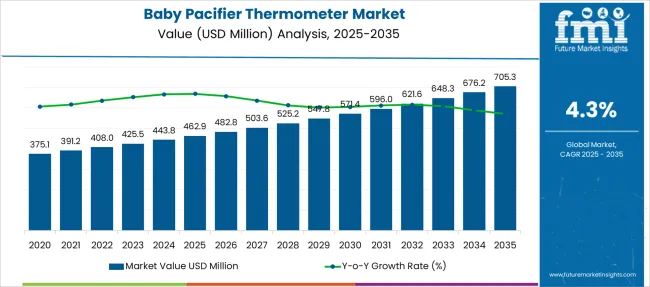
| Metric | Value |
|---|---|
| Baby Pacifier Thermometer Market Estimated Value in (2025 E) | USD 462.9 million |
| Baby Pacifier Thermometer Market Forecast Value in (2035 F) | USD 705.3 million |
| Forecast CAGR (2025 to 2035) | 4.3% |
The baby pacifier thermometer market is experiencing consistent growth, driven by heightened awareness among parents regarding infant health and the importance of continuous, stress-free temperature monitoring. As baby healthcare becomes increasingly integrated with smart, user-friendly technologies, pacifier thermometers are gaining traction due to their non-intrusive design and ease of use. Growth is being supported by the convergence of baby care innovation with digital health, allowing temperature data to be captured more comfortably during sleep or feeding without disrupting the child.
The market is also responding to rising disposable incomes, urban parenting trends, and the growing emphasis on real-time health tracking. Regulatory approvals and increasing pediatric recommendations are contributing to trust and safety perceptions around these devices.
Looking ahead, manufacturers are expected to invest further in features such as app integration, soft material enhancements, and advanced sensors to improve usability The future outlook remains positive as both technology acceptance and infant health consciousness continue to rise globally.
The market is segmented by End Use, Battery Type, and Sales Channels and region. By End Use, the market is divided into Household, Healthcare Centers, Clinic, Hospitals and Nursing Homes, and Others. In terms of Battery Type, the market is classified into In-Built and External battery. Based on Sales Channels, the market is segmented into Online and Offline. Regionally, the market is classified into North America, Latin America, Western Europe, Eastern Europe, Balkan & Baltic Countries, Russia & Belarus, Central Asia, East Asia, South Asia & Pacific, and the Middle East & Africa.
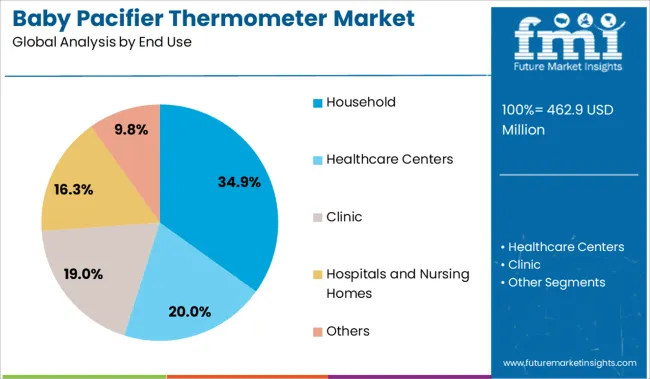
The household segment is projected to hold 34.9% of the total revenue share in the baby pacifier thermometer market in 2025. This growth has been influenced by the increasing prioritization of home-based health monitoring solutions among modern parents who seek convenience, accuracy, and non-invasive tools to care for infants. Baby pacifier thermometers are being increasingly adopted for household use due to their ability to monitor temperature without causing discomfort, especially during sleep.
The flexibility to perform regular health checks at home without clinical visits has been a key factor driving demand in this segment. In addition, heightened health awareness following recent global health crises has shifted consumer focus toward proactive health tracking at home.
The household environment provides an ideal use case for these thermometers, given the need for round-the-clock monitoring and the preference for technologies that blend easily into daily routines Rising nuclear family structures and digital parenting trends have further supported the segment’s upward trajectory.
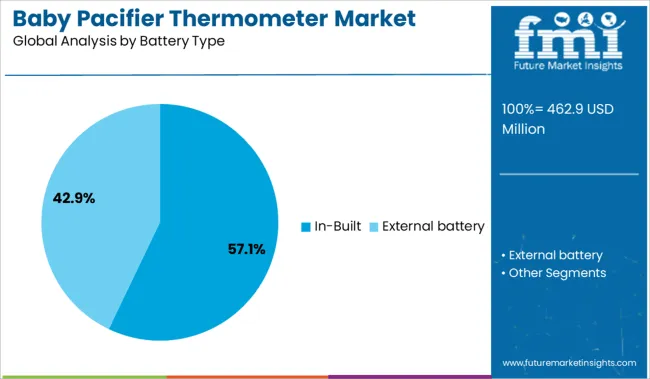
The in-built battery type is anticipated to account for 57.1% of the baby pacifier thermometer market’s revenue share in 2025. This segment’s dominance is being driven by the convenience and reliability offered by integrated power solutions, which eliminate the need for frequent battery replacement. Parents are increasingly favoring in-built battery thermometers for their seamless usability, reduced maintenance, and longer operational cycles.
These products often come with sealed, water-resistant designs that enhance safety and hygiene, particularly important for infant care. The assurance of consistent power supply during monitoring sessions has been a key factor in the widespread adoption of this battery configuration.
In-built batteries also support compact, lightweight product designs, which are more comfortable for infants and reduce the risk of accidental damage or ingestion Enhanced durability and simplified manufacturing processes have further enabled manufacturers to scale production while maintaining quality standards, supporting the continued growth of this segment in the global market.
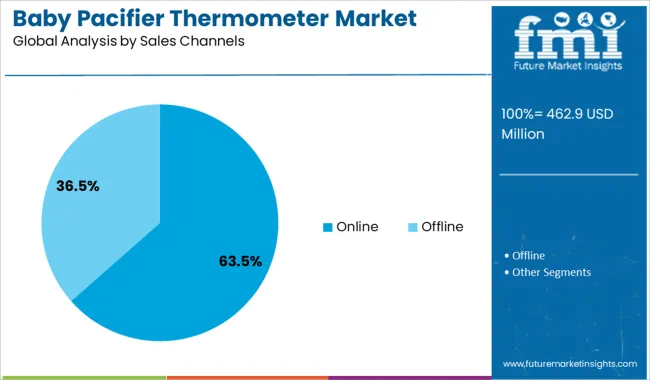
The online sales channel is expected to represent 63.5% of the total revenue share in the baby pacifier thermometer market in 2025, making it the most prominent distribution pathway. The increasing reliance on e-commerce platforms for baby care products has been a major contributor to this trend, driven by convenience, variety, and access to user reviews. Consumers are turning to online channels for purchasing healthcare devices due to the availability of detailed product information, brand comparisons, and fast delivery services.
The rise of digital-first parenting and higher smartphone penetration has further influenced buying behaviors, especially among young parents in urban and semi-urban regions. Promotions, discounts, and bundled offers available on online marketplaces have enhanced product affordability and visibility.
Additionally, direct-to-consumer strategies adopted by manufacturers through proprietary websites and social media engagement have enabled better customer education and trust The accessibility and transparency offered by online platforms are expected to continue supporting the dominance of this sales channel.
Drivers for Baby Pacifier Thermometer Market
Another growth in the healthcare industry and an increasing number of hospitals and healthcare centers across the globe is supporting the higher demand for baby pacifier thermometers. This development has resulted in a greater baby pacifier thermometer market share, which in turn is witnessing growth in terms of value.
Trends for Baby Pacifier Thermometer Market
Manufacturers are principally involved in manufacturing baby pacifier thermometers which are very safe for baby’s skin and also comfortable for babies to hold in their mouths. Moreover, most of the manufacturers are principally engaged in sales of baby pacifier thermometers through third-party e-commerce Companies to increase the baby pacifier thermometer market share globally.
Opportunities for Baby Pacifier Thermometer Market
The addition of advanced features in the baby pacifier thermometer and affordability in the price in the near future is expected to be the main attraction for the higher sales of baby pacifier thermometers. And due to the growth of the electronics industry globally, the demand for the baby pacifier thermometer market has benefited immensely.
Challenges to Baby Pacifier Thermometer Market
Baby Pacifier Thermometer is not very accurate and takes a comparatively long time, about three to five minutes, to measure baby’s temperature. Thus, some customers are interested in purchasing ear thermometers, no-contact forehead infrared thermometers, and other products. This factor is expected to challenge the growth in demand for baby pacifier thermometers.
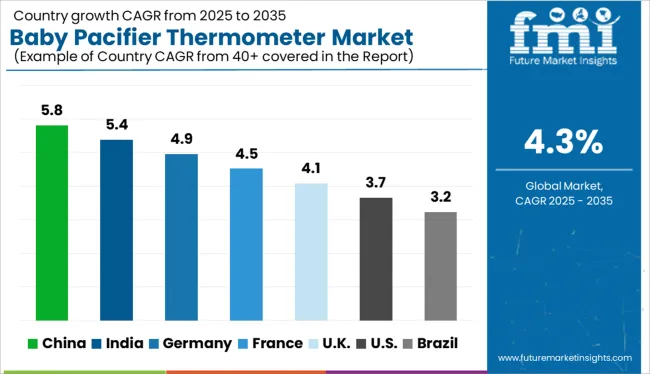
Increasing internet penetration in developing countries is one of the key factors responsible for increasing awareness among end-users and higher sales of baby pacifier thermometers to them. Moreover, e-commerce companies are increasing sales of baby pacifier thermometers by penetrating countries around the world.
The ease in the availability of the baby pacifier thermometer and the presence of a large number of players in the North America and Europe region is responsible for a significant baby pacifier thermometer market share in these regions. Europe is also a very attractive region in the globe for demand for baby pacifier thermometers.
The rapid growth of the electronics industry in the Asia Pacific region is expected to fuel the growth in sales of baby pacifier thermometers during the forecast period as this region contains the highest rate of population count, so the regional baby pacifier thermometer market is anticipated to be of the highest value by the end of the forecast period.
Demand for baby pacifier thermometers through e-commerce platforms is significantly growing in the Latin America region. Middle East and Africa are expected to witness slow growth of baby pacifier thermometer market share due to comparatively less awareness of the products due to the slow internet situation in these regions.
Increasing disposable income in Latin America and the Asia Pacific region, and increasing urbanization are some of the factors positively influencing the growth of the baby pacifier thermometer market.
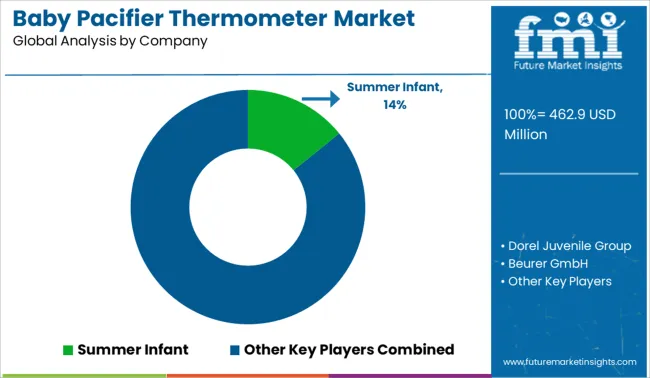
Some of the key players in the global baby pacifier thermometer market include Summer Infant, Dorel Juvenile Group, Beurer GmbH, Lanaform, Microlife, Terraillon, BRiGGS, Kuteks, Little Doctor, Rumble Tuff, B.Well, Vega, Valeo, Babyvelle and Hunkar.
Major Developments in the Baby Pacifier Thermometer Market
As the market players are focusing on adding new features such as memory features, fever alert glow, and comfortable orthodontic nipples, it is increasing the sales of baby pacific thermometers in terms of volume and attracting customers across the globe.
The demand for baby pacifier thermometers in healthcare centers, hospitals, and other places is witnessing significant growth in recent times.
| Report Attribute | Details |
|---|---|
| Growth Rate | CAGR of 4.3% from 2025 to 2035 |
| Base Year of Estimation | 2024 |
| Historical Data | 2014 to 2024 |
| Forecast Period | 2025 to 2035 |
| Quantitative Units | Revenue in USD Billion, Volume in Kilotons, and CAGR from 2025 to 2035 |
| Report Coverage | Revenue Forecast, Volume Forecast, Company Ranking, Competitive Landscape, Growth Factors, Trends, and Pricing Analysis |
| Segments Covered | End Use, Distribution Channel, Battery Requirement, Region |
| Regions Covered | North America; Latin America; Western Europe; Eastern Europe; Asia Pacific Excluding Japan; Japan; Middle East and Africa |
| Key Countries Profiled | USA, Canada, Brazil, Argentina, Germany, United Kingdom, France, Spain, Italy, Nordics, BENELUX, Australia & New Zealand, China, India, ASIAN, GCC Countries, South Africa |
| Key Companies Profiled | Summer Infant; Dorel Juvenile Group; Beurer GmbH; Lanaform; Microlife; Terraillon; Briggs; Kuteks; Little Doctor; Rumble Tuff; B.Well; Vega; Valeo; Babyvelle; Hunkar |
| Customization scope | Available Upon Request |
| Pricing and Purchase Option | Avail of Customized purchase options to meet your exact research needs. |
The global baby pacifier thermometer market is estimated to be valued at USD 462.9 million in 2025.
The market size for the baby pacifier thermometer market is projected to reach USD 705.3 million by 2035.
The baby pacifier thermometer market is expected to grow at a 4.3% CAGR between 2025 and 2035.
The key product types in baby pacifier thermometer market are household, healthcare centers, clinic, hospitals and nursing homes and others.
In terms of battery type, in-built segment to command 57.1% share in the baby pacifier thermometer market in 2025.






Full Research Suite comprises of:
Market outlook & trends analysis
Interviews & case studies
Strategic recommendations
Vendor profiles & capabilities analysis
5-year forecasts
8 regions and 60+ country-level data splits
Market segment data splits
12 months of continuous data updates
DELIVERED AS:
PDF EXCEL ONLINE
Baby Changing Station Market Size and Share Forecast Outlook 2025 to 2035
Baby Car Safety Seat Market Forecast and Outlook 2025 to 2035
Baby Bath and Shower Products Market Size and Share Forecast Outlook 2025 to 2035
Baby Doll Market Size and Share Forecast Outlook 2025 to 2035
Baby & Toddler Carriers & Accessories Market Size and Share Forecast Outlook 2025 to 2035
Baby Shoes Market Size and Share Forecast Outlook 2025 to 2035
Baby Oral Care Market Size and Share Forecast Outlook 2025 to 2035
Baby Food Dispensing Spoon Market Size and Share Forecast Outlook 2025 to 2035
Baby Crib Sheet Market Size and Share Forecast Outlook 2025 to 2035
Baby Teeth Care Products Market Size and Share Forecast Outlook 2025 to 2035
Baby Food Market Analysis - Size, Share, and Forecast Outlook 2025 to 2035
Baby Diaper Market Growth, Forecast, and Trend Analysis 2025 to 2035
Baby Powder Market - Size, Share, and Forecast 2025 to 2035
Baby Sling Market Size and Share Forecast Outlook 2025 to 2035
Baby Bottle Holder Market Size and Share Forecast Outlook 2025 to 2035
Baby Toddler Bar Market Analysis - Size, Share, and Forecast Outlook 2025 to 2035
Baby Snacks Market Analysis - Size, Share, & Forecast Outlook 2025 to 2035
Baby Oil Market Analysis - Size, Share, and Forecast Outlook 2025 to 2035
Baby Food Packaging Market Analysis - Size, Share, and Forecast Outlook 2025 to 2035
Baby Milk Market Analysis - Size, Share, & Forecast Outlook 2025 to 2035

Thank you!
You will receive an email from our Business Development Manager. Please be sure to check your SPAM/JUNK folder too.
Chat With
MaRIA